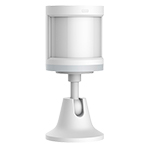| title | description | addedAt | pageClass |
|---|---|---|---|
Xiaomi RTCGQ11LM control via MQTT |
Integrate your Xiaomi RTCGQ11LM via Zigbee2MQTT with whatever smart home infrastructure you are using without the vendor's bridge or gateway. |
2019-07-22 20:08:17 UTC |
device-page |
| Model | RTCGQ11LM |
| Vendor | Xiaomi |
| Description | Aqara human body movement and illuminance sensor |
| Exposes | battery, occupancy, device_temperature, voltage, illuminance_lux, illuminance, power_outage_count, linkquality |
| Picture |  |
Uses a CR2450 battery.
Press and hold the reset button on the device for +- 5 seconds (until the blue light starts blinking). After this the device will automatically join. If this doesn't work, try with a single short button press.
In some cases where users are using a CC2531 USB stick (see Koenkk/zigbee2mqtt#839) performing a shutdown of Zigbee2MQTT, removing and reinserting the USB stick, then restarting Zigbee2MQTT has proven successful for pairing via the above method when it has not been working.
Since Xiaomi devices do not fully comply to the Zigbee standard, it sometimes happens that they disconnect from the network. Most of the times this happens because of the following reasons:
- Device has a weak signal, you can see the signal quality in the published messages as
linkquality. A linkquality < 20 is considered weak. - Low battery voltage, this can even happen when the battery still appears full. Try a different battery.
- The device is connected through a router which cannot deal with Xiaomi devices. This is known to happen devices from: Centralite, General Electric, Iris, Ledvance, Legrand, OSRAM, Sylvania, SmartThings, Securifi. A possible solution is to connect the device directly to the central coordinator by pushing the reset button while being physically close to it.
More detailed information about this can be found here.
occupancy_timeout should not be set to lower than 60 seconds.
The reason is this: after detecting a motion the sensor ignores any movements for
exactly 60 seconds. In case there are movements after this 60 seconds, a new message
(occupancy: true) will be sent and the sensor will go to sleep for another minute, and so on.
Therefore, in order to sustain occupancy: true, you need a reasonable window after this 60s sleep
to determine continued occupancy.
This is expected behaviour (see #270).
To work around this, a
hardware modification
is needed.
How to use device type specific configuration
-
device_temperature_calibration: Calibrates the device_temperature value (absolute offset), takes into effect on next report of device. The value must be a number. -
illuminance_lux_calibration: Calibrates the illuminance_lux value (percentual offset), takes into effect on next report of device. The value must be a number. -
illuminance_calibration: Calibrates the illuminance value (percentual offset), takes into effect on next report of device. The value must be a number. -
occupancy_timeout: Time in seconds after which occupancy is cleared after detecting it (default 90 seconds). The value must be a number with a minimum value of0 -
no_occupancy_since: Sends a message the last time occupancy (occupancy: true) was detected. When setting this for example to [10, 60] a{"no_occupancy_since": 10}will be send after 10 seconds and a{"no_occupancy_since": 60}after 60 seconds. The value must be a list of [object Object].
Remaining battery in %, can take up to 24 hours before reported..
Value can be found in the published state on the battery property.
It's not possible to read (/get) or write (/set) this value.
The minimal value is 0 and the maximum value is 100.
The unit of this value is %.
Indicates whether the device detected occupancy.
Value can be found in the published state on the occupancy property.
It's not possible to read (/get) or write (/set) this value.
If value equals true occupancy is ON, if false OFF.
Temperature of the device.
Value can be found in the published state on the device_temperature property.
It's not possible to read (/get) or write (/set) this value.
The unit of this value is °C.
Voltage of the battery in millivolts.
Value can be found in the published state on the voltage property.
It's not possible to read (/get) or write (/set) this value.
The unit of this value is mV.
Measured illuminance in lux.
Value can be found in the published state on the illuminance property.
It's not possible to read (/get) or write (/set) this value.
The unit of this value is lx.
Measured illuminance in lux.
Value can be found in the published state on the illuminance property.
It's not possible to read (/get) or write (/set) this value.
The unit of this value is lx.
Number of power outages.
Value can be found in the published state on the power_outage_count property.
It's not possible to read (/get) or write (/set) this value.
Link quality (signal strength).
Value can be found in the published state on the linkquality property.
It's not possible to read (/get) or write (/set) this value.
The minimal value is 0 and the maximum value is 255.
The unit of this value is lqi.